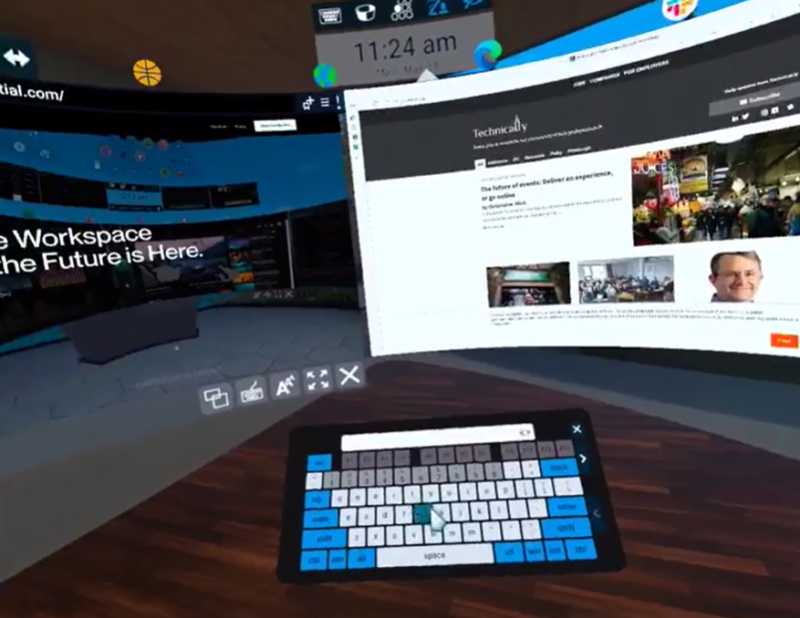One thing that never crossed my mind when I got the Quest 2 was using it for work.
When I first picked up my headset, I was thinking about immersing myself in Google Earth, some indoor fitness, maybe focused meditation for stress. I’d played with virtual reality before, including for a story at CTRL V in Bear, Delaware, and it seemed like a fun gadget to have for some serious escapism.
And I’d heard of the metaverse — mainly VRChat, a social program filled with carefully crafted custom avatars, that went viral in 2021 after a user named Coopertom recreated Four Seasons Total Landscaping after the infamous Giuliani press conference shortly after the 2020 election.
But could I use this tech to write an article in a relaxing VR workspace with a mountain view? I set out to find out.
VR beyond recreation
It’s hard to explain the metaverse, but in its simplest terms, it’s the internet, but fully immersive. When you log in on a Quest VR headset, you’ll find, on the main screen in your selected immersive home environment, a calendar of upcoming live events — say, 6 a.m. workouts, discussion panels, film screenings, concerts. Some are free, some have a ticket price. While cryptocurrency is considered inseparable from the metaverse, for now, non-crypto currency is accepted in the metaverse via Google Pay.
Entering a common VR space for the first time is surreal. Avatars mingle together, as the sound of multiple conversations and languages surround you. During my first foray into the VR social app Horizon Worlds, a solo avatar hovered beside me for a moment and waved. I waved back, my digital hand in my peripheral view. They floated away. A real person.
(Had my momentary acquaintance instead behaved inappropriately, I could have put what is essentially a forcefield up around myself, making me invisible to others. I could then leave or move to a different place, or, if the user was especially bad, report them.)
If you don’t like talking to strangers, you can meet up with friends on the platform. You can watch movies with friends who live thousands of miles away, as if you’re sitting together in a movie theater for living room. It’s wild.
I would soon find that the Quest 2 is also actually great for things like online research and watching informational panels and talks on the YouTube app. Focus and concentration are heightened, and distractions are filtered out. I could essentially spend my work day at home surrounded by multiple screens, meeting portals and an all-important functional VR keyboard — but within the virtual setting of my choice.
I tried two apps: Immersed and vSpatial. Both connect to your PC or Mac, allowing you to work on your computer within the VR space. Both have a learning curve, especially when it comes to typing (at least for a non-gamer like myself). Both offer distraction free, aesthetically pleasing workspaces.
vSpatial
Of the two apps I tried, vSpatial was the more intuitive, requiring less tutorial. It connects to your computer via Bluetooth, and device connection happens automatically when you open the app as long as your computer is on and nearby.
If you know how to use the Quest controllers to pick things up and move them, you can quickly start setting up your workspace carousel with screens, both from your computer and its internal features, including a browser and an arcade game.
The keyboard has three options, including a “passthrough” feature where you can (sort of) see your actual keyboard through the camera on the front of your headset, as well as a tracked feature that connects your computer keyboard to the virtual keyboard and an internal point-and-click keyboard. This is where the learning curve is steepest for me. I’m still using point-and-click on this app, because passthrough is too distracting to be worth working in a VR workspace in the first place, and I’ve had issues connecting to the tracked keyboard.
Overall, vSpatial offers a relaxing atmosphere — a mountain view that can be turned off so you’re working with nothing but your work screens in view — and is fairly easy to maneuver.
Watch my rundown of vSpatial:
https://www.facebook.com/1647399145/videos/656839328729896/
Immersed
When you open the Immersed app for the first time, you’re greeted by an avatar guide who walks you through connecting your computer and gives a quick tutorial on using the controllers — or your hands as controllers, which you’ll need to do to use the typewriter connected to your computer.
The tutorial didn’t answer my big question: How do I use my hands to type? After some trial and error, I managed to sync my laptop keyboard with the app’s keyboard and was able to type random letters with my fingers. I figured out that I had to turn off the feature that makes your hands active controllers in order to hit the correct keys (sometimes). The learning curve here is steep; I say that as someone who has no problem writing whole essays or articles quickly on my phone. It’s something I’m sure I’ll get the hang of, but I’m not there yet.
Immersed offers a variety of settings for your workspace, from a lakeside lodge to places that look like they’re out of a video game to a standard-looking conference room.
Immersed isn’t quite as intuitive as vSpatial, but once you pick it up, it’s easy enough to use for research, email, Slack and other smaller tasks. Eventually I can see being able to do everything including writing articles in the workspace.
Here’s my Immersed rundown:
https://www.facebook.com/harlequinn823/videos/381493767176987/
So, what’s the verdict?
In the end, no, I didn’t write this entire article in VR.
Will I continue to use VR for work? I’ll definitely use it to watch things like virtual panels. I’ll definitely use the VR browser at least some of the time for work, simply because the headset is a good way to get focused when you find yourself distracted at your desk.
I don’t necessarily need a VR workspace to do those things, though. YouTube is probably the VR best platform for video, including viewing video not made for VR — non-360/180VR video feels like watching a movie in a movie theater.
The Quest’s built-in browser works well enough for searching and sharing. But where a VR workspace shines is in its ability to keep you in your workday loop. Slack is there, your email is there, exactly as it is on your laptop. Everything is exactly like your laptop, because it literally is, and that makes it more of a connected workspace, even if your coworkers aren’t using VR.
It will be a few years (maybe more, maybe less) before the virtual workspace is fully usable for the average remote worker, and the success of VR workspaces will hinge on whether they — and the metaverse itself — become the norm, like Zoom or Slack. That won’t be happening tomorrow, but it could happen.

This editorial article is a part of Web3 Month of Technical.ly's 2022 editorial calendar.
Before you go...
Please consider supporting Technical.ly to keep our independent journalism strong. Unlike most business-focused media outlets, we don’t have a paywall. Instead, we count on your personal and organizational support.
Join our growing Slack community
Join 5,000 tech professionals and entrepreneurs in our community Slack today!

The person charged in the UnitedHealthcare CEO shooting had a ton of tech connections

Delaware students take a field trip to China using their tablets and ChatGPT

From rejection to innovation: How I built a tool to beat AI hiring algorithms at their own game


